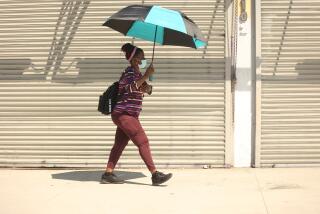Learn about heatstroke before it’s an emergency
- Share via
Worry about earthquakes if you want, but old-fashioned heat might pose a bigger threat.
“Historically, from 1979 to 2003, excessive heat exposure caused 8,015 deaths in the United States. During this period, more people in this country died from extreme heat than from hurricanes, lightning, tornadoes, floods and earthquakes combined. In 2001, 300 deaths were caused by excessive heat exposure.”
So begins the heatstroke prevention guide from the federal Centers for Disease Control and Prevention: “Extreme Heat: A Prevention Guide to Promote Your Personal Health and Safety.”
The data might not be quite up-to-date, but the guide itself is a gold mine of information, going beyond the usual “drink plenty of fluids” and “don’t go outside during the hottest part of the day” generic advice. Sure, those suggestions are included, but so are these:
Take special care if you have heart disease or high blood pressure or – please note – you’re taking medication for depression, insomnia or poor circulation. (And these days, who isn’t?)
Skip hot foods and heavy meals. They’ll just add heat to your body.
Drink cool fluids, but not icy ones, which can cause cramping.
Wear as little clothing as possible (i.e. as your housemates will permit) when at home.
See? Good stuff.
There’s more, of course, including how to recognize the signs of heatstroke (hot skin, rapid pulse, headache, dizziness, nausea) and what to do about it (cool down as rapidly as possible – by any means necessary).
The guide also distinguishes between heatstroke and heat exhaustion (a milder form of heat illness that develops after several days of high heat and poor fluid intake). The elderly, people who work or exercise outside and people with high blood pressure (which is a lot of people – about a third of Americans have hypertension) are most at risk.
The guide even offers advice on what to do about heat rash and heat cramps. It’s worth checking out – before the mercury hits its peak.
And here’s more from eHow on medications that increase the risk of heatstroke.






